Abstract
Many viruses capable of persistent or recurrent infections have evolved strategies to evade host immunity. Viral evasion molecules target components of innate and acquired immunity, including complement proteins, natural killer cells, MHC Class I or Class II molecules and antibody. Our work focuses on HSV-1 glycoproteins gC and gE that impair antibody and complement responses. gC inhibits complement activation by binding C3b and blocking activities mediated by this pivotal complement protein, while gE binds the IgG Fc domain, blocking Fc-mediated activities, including complement activation and antibody-dependent cellular cytotoxicity. HSV-1 mutant viruses that lack the ability to bind C3b, IgG Fc, or both are much less virulent than wild-type virus in a murine model. These HSV-1 immunoevasins help explain the virus' ability to produce recurrent infections despite intact immunity. Strategies to prevent immune evasion may be required to develop successful HSV vaccines.
Full text
PDF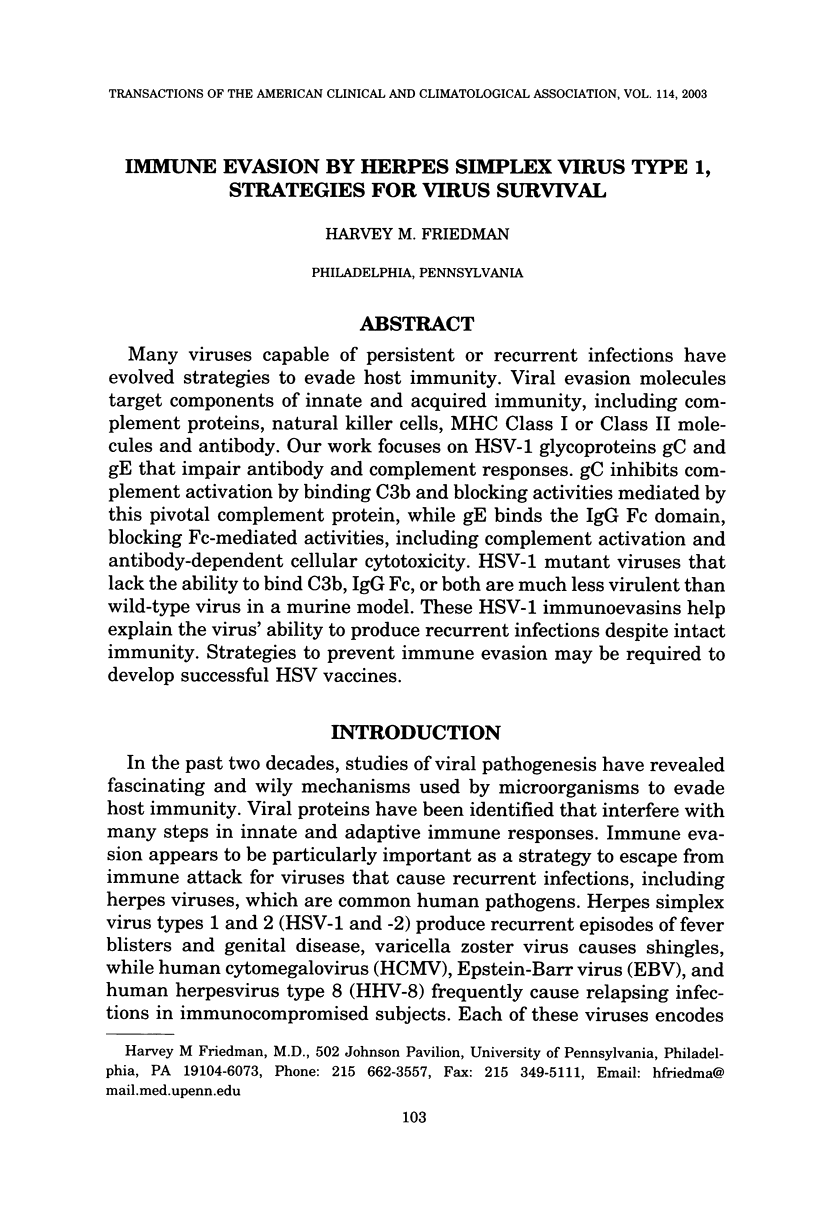
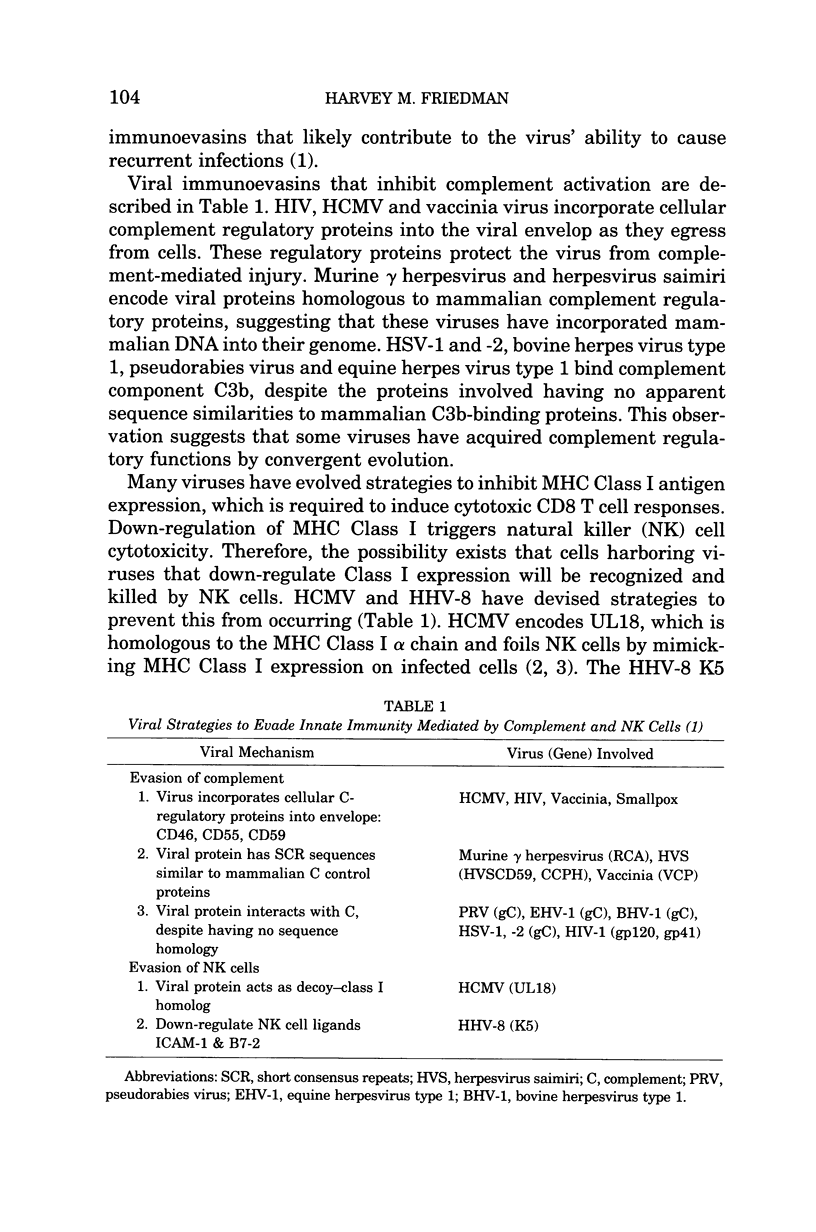
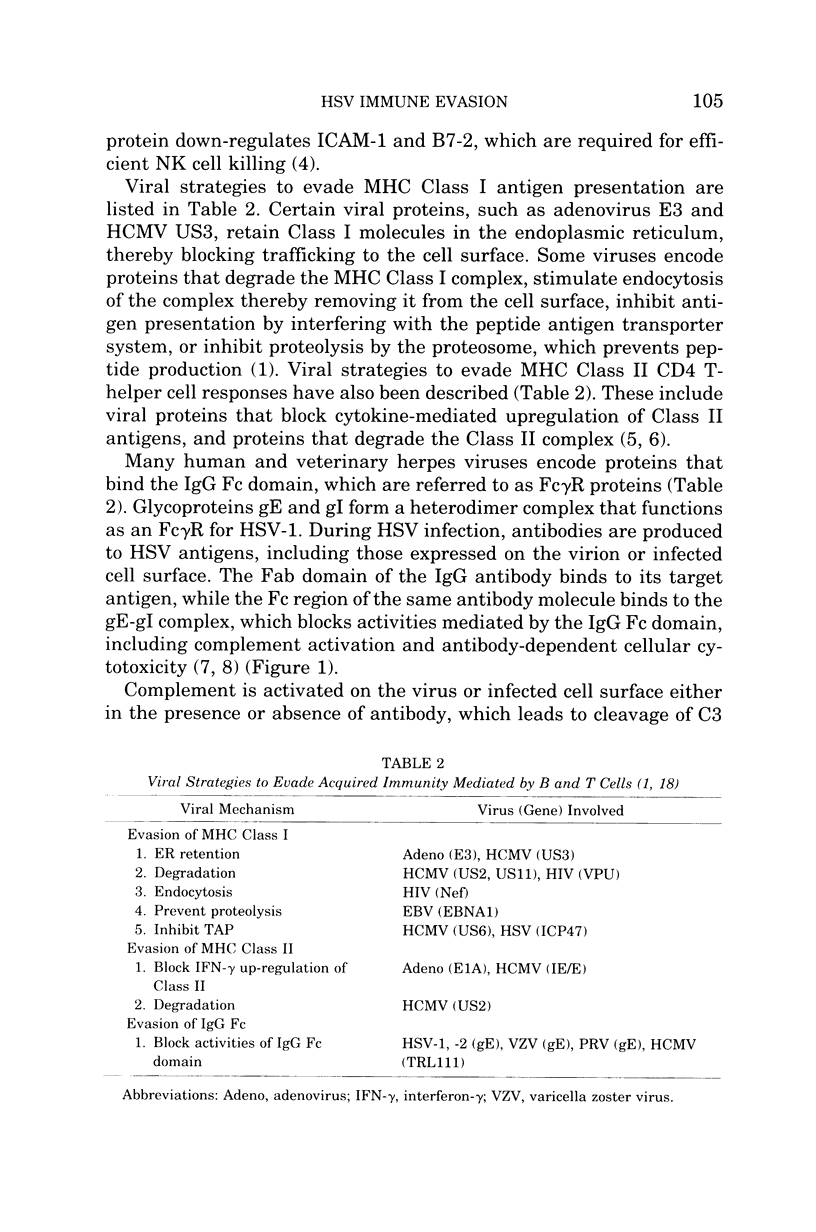
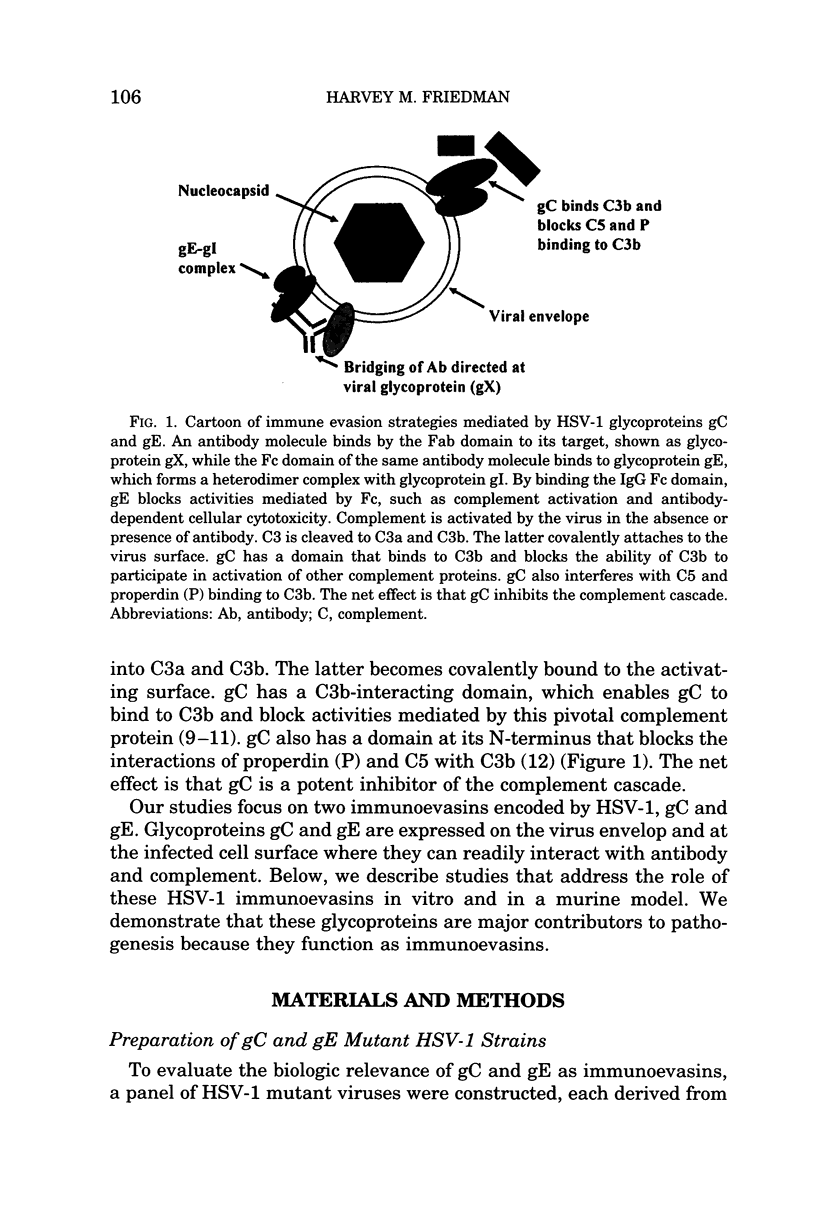
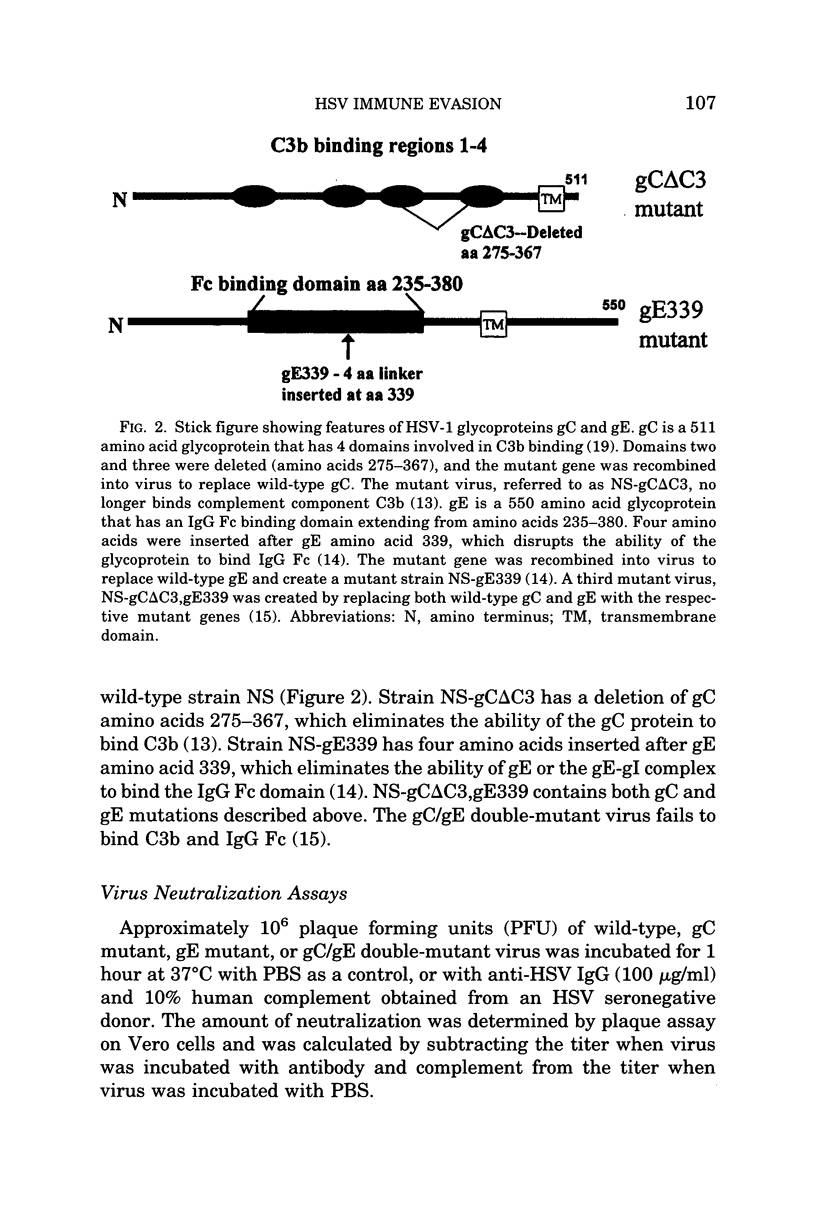
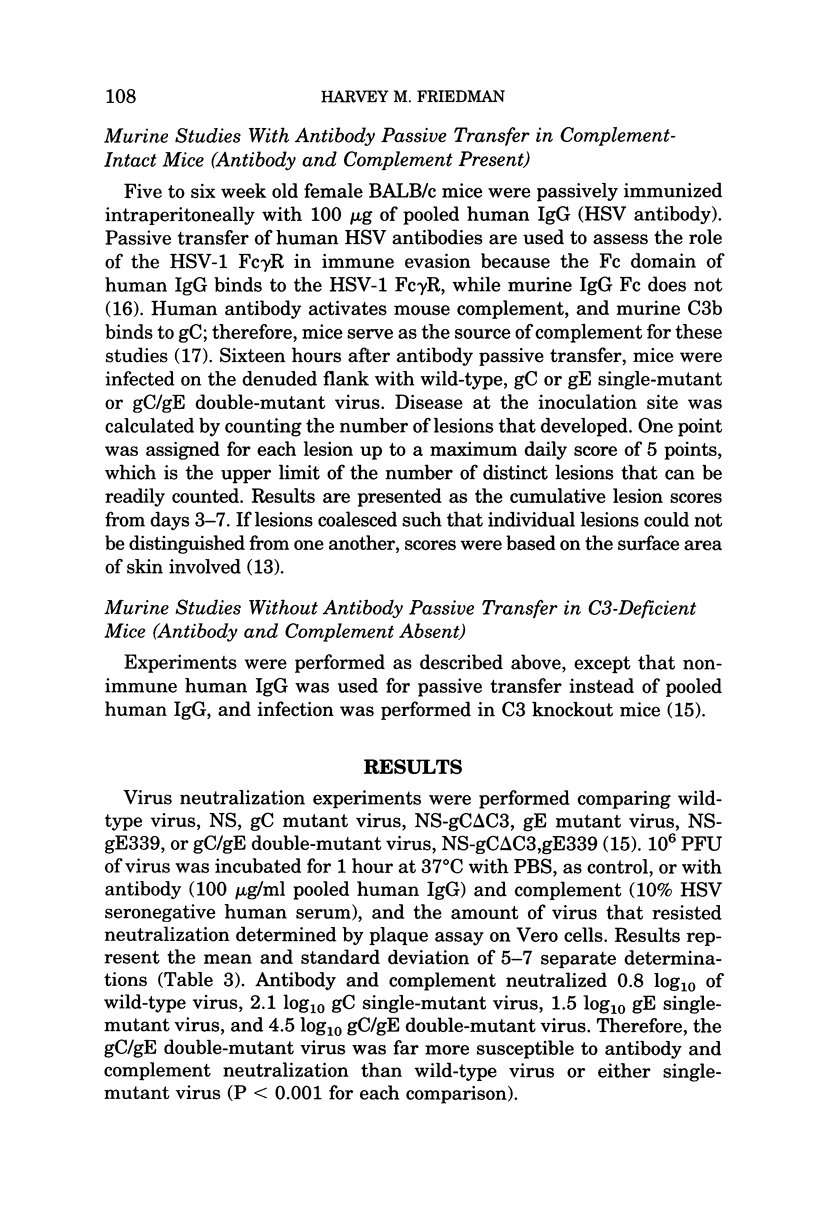
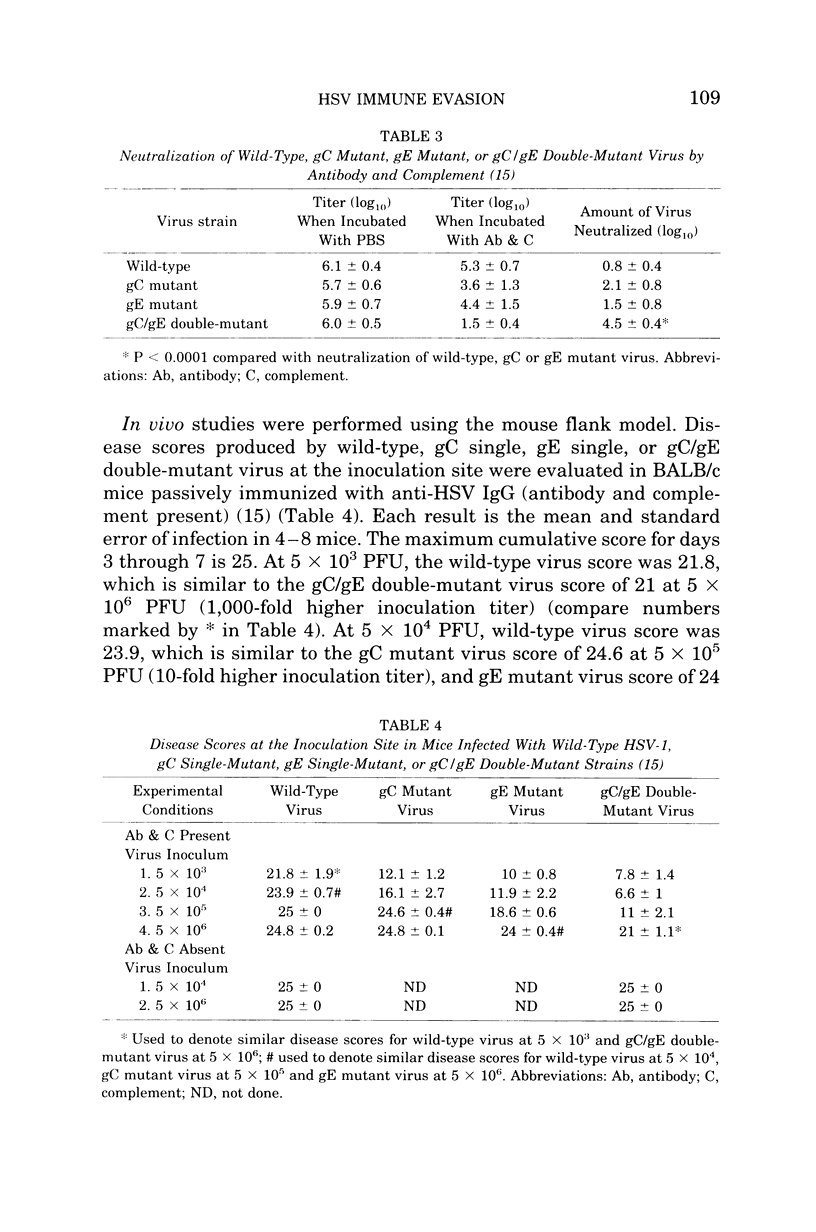
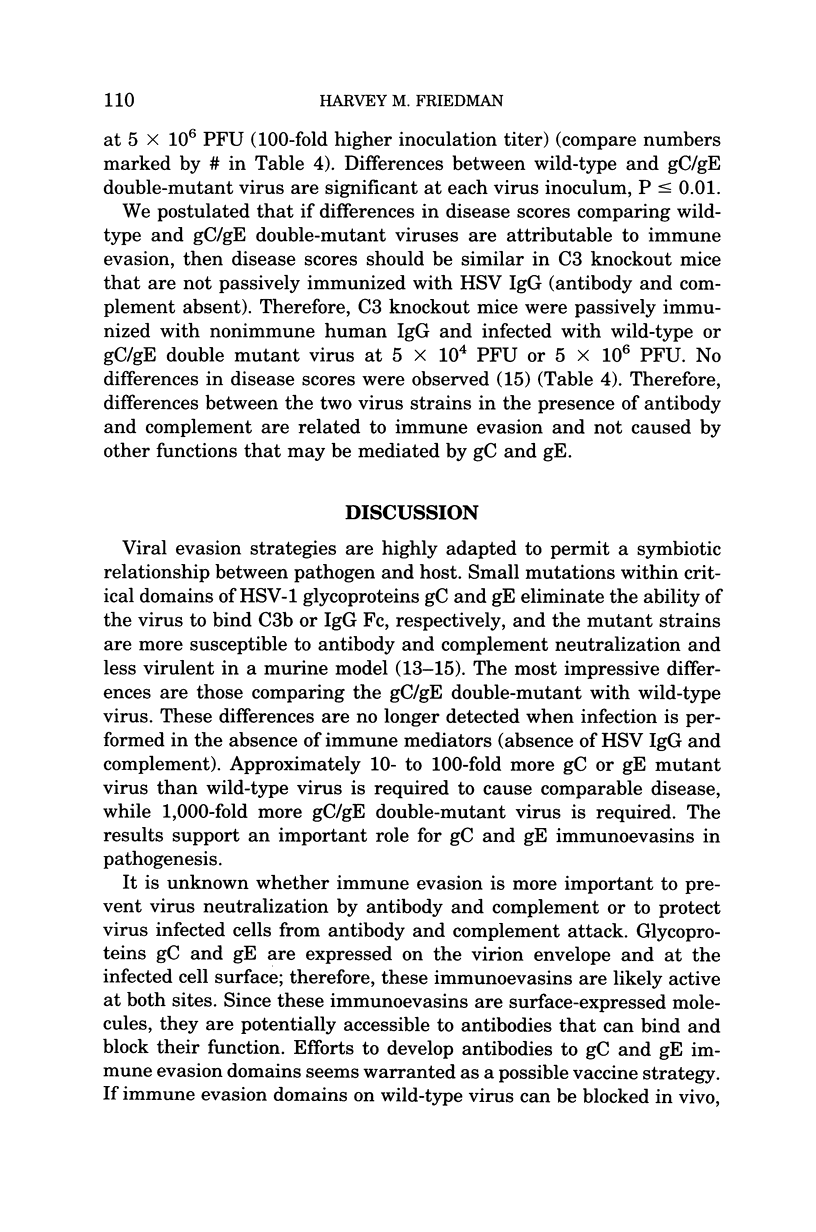
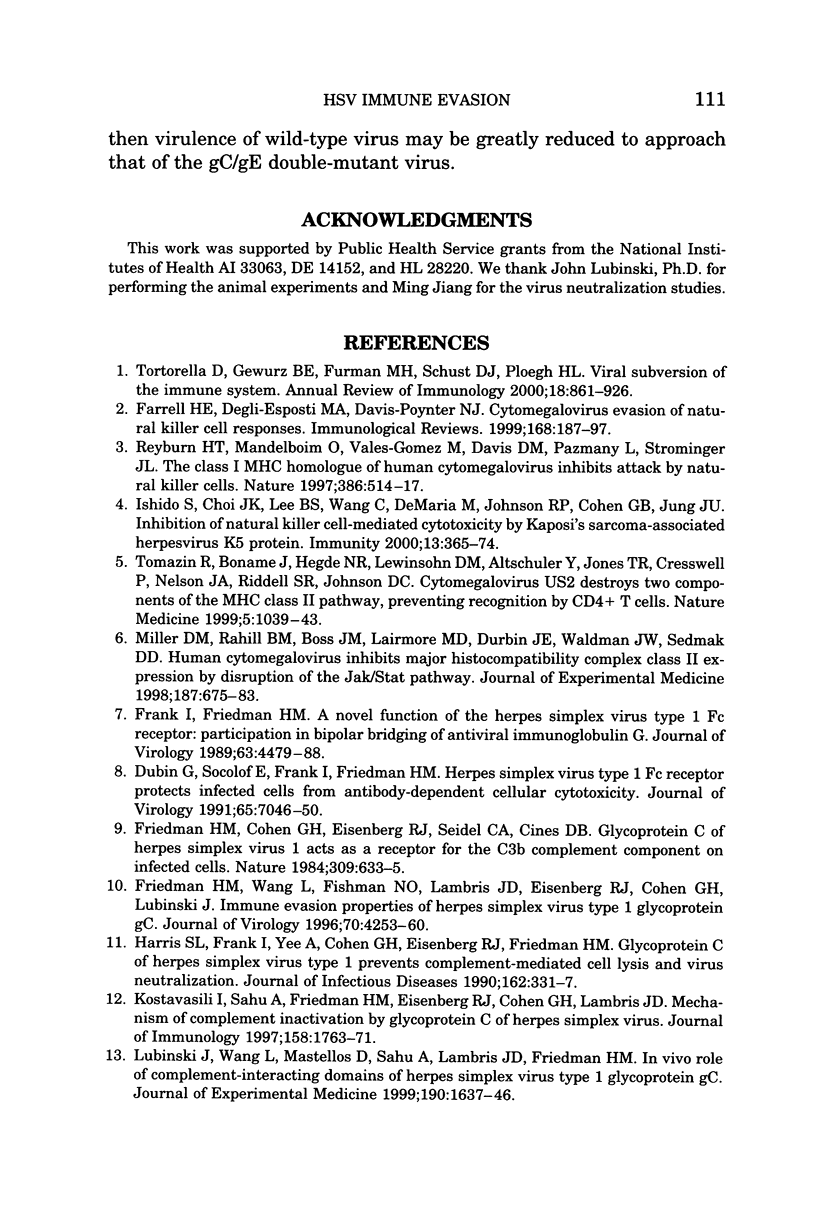
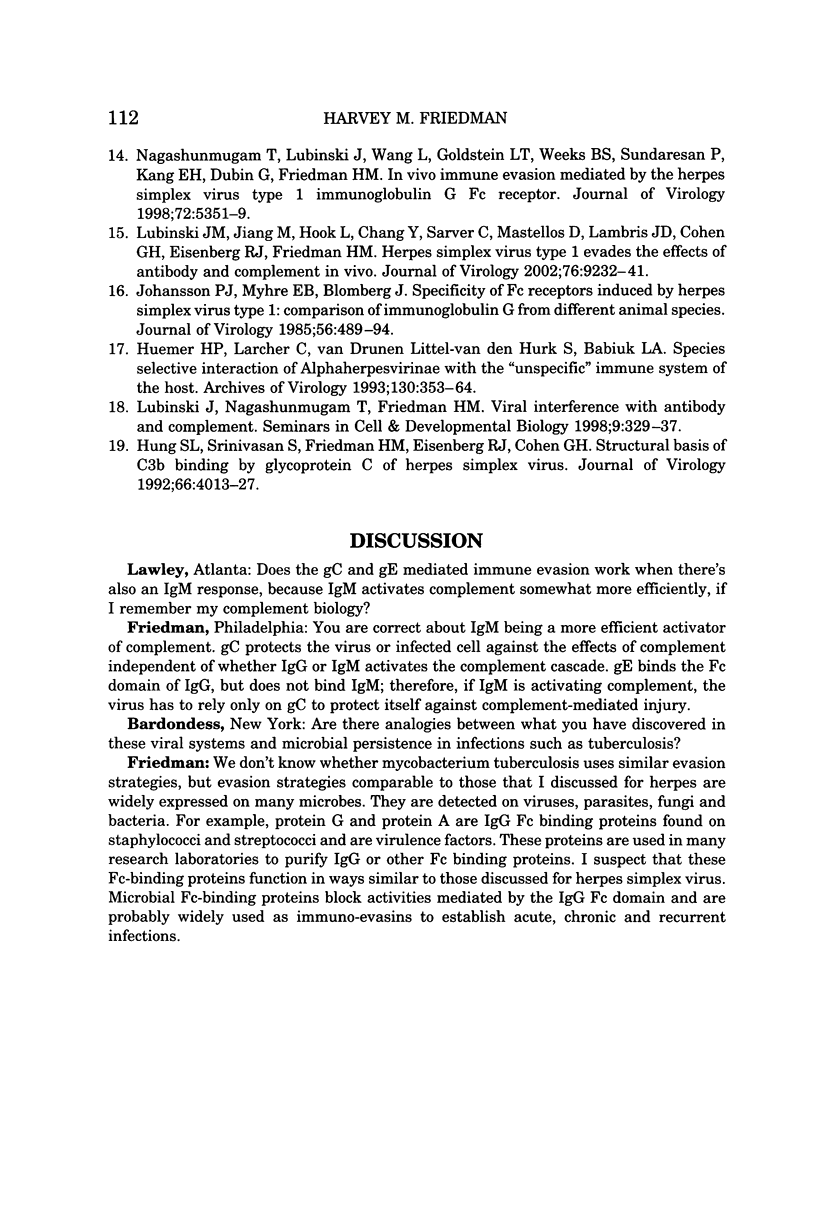
Selected References
These references are in PubMed. This may not be the complete list of references from this article.
- Dubin G., Socolof E., Frank I., Friedman H. M. Herpes simplex virus type 1 Fc receptor protects infected cells from antibody-dependent cellular cytotoxicity. J Virol. 1991 Dec;65(12):7046–7050. doi: 10.1128/jvi.65.12.7046-7050.1991. [DOI] [PMC free article] [PubMed] [Google Scholar]
- Farrell H. E., Degli-Esposti M. A., Davis-Poynter N. J. Cytomegalovirus evasion of natural killer cell responses. Immunol Rev. 1999 Apr;168:187–197. doi: 10.1111/j.1600-065x.1999.tb01293.x. [DOI] [PubMed] [Google Scholar]
- Frank I., Friedman H. M. A novel function of the herpes simplex virus type 1 Fc receptor: participation in bipolar bridging of antiviral immunoglobulin G. J Virol. 1989 Nov;63(11):4479–4488. doi: 10.1128/jvi.63.11.4479-4488.1989. [DOI] [PMC free article] [PubMed] [Google Scholar]
- Friedman H. M., Cohen G. H., Eisenberg R. J., Seidel C. A., Cines D. B. Glycoprotein C of herpes simplex virus 1 acts as a receptor for the C3b complement component on infected cells. Nature. 1984 Jun 14;309(5969):633–635. doi: 10.1038/309633a0. [DOI] [PubMed] [Google Scholar]
- Friedman H. M., Wang L., Fishman N. O., Lambris J. D., Eisenberg R. J., Cohen G. H., Lubinski J. Immune evasion properties of herpes simplex virus type 1 glycoprotein gC. J Virol. 1996 Jul;70(7):4253–4260. doi: 10.1128/jvi.70.7.4253-4260.1996. [DOI] [PMC free article] [PubMed] [Google Scholar]
- Harris S. L., Frank I., Yee A., Cohen G. H., Eisenberg R. J., Friedman H. M. Glycoprotein C of herpes simplex virus type 1 prevents complement-mediated cell lysis and virus neutralization. J Infect Dis. 1990 Aug;162(2):331–337. doi: 10.1093/infdis/162.2.331. [DOI] [PubMed] [Google Scholar]
- Huemer H. P., Larcher C., van Drunen Littel-van den Hurk S., Babiuk L. A. Species selective interaction of Alphaherpesvirinae with the "unspecific" immune system of the host. Arch Virol. 1993;130(3-4):353–364. doi: 10.1007/BF01309666. [DOI] [PubMed] [Google Scholar]
- Hung S. L., Srinivasan S., Friedman H. M., Eisenberg R. J., Cohen G. H. Structural basis of C3b binding by glycoprotein C of herpes simplex virus. J Virol. 1992 Jul;66(7):4013–4027. doi: 10.1128/jvi.66.7.4013-4027.1992. [DOI] [PMC free article] [PubMed] [Google Scholar]
- Ishido S., Choi J. K., Lee B. S., Wang C., DeMaria M., Johnson R. P., Cohen G. B., Jung J. U. Inhibition of natural killer cell-mediated cytotoxicity by Kaposi's sarcoma-associated herpesvirus K5 protein. Immunity. 2000 Sep;13(3):365–374. doi: 10.1016/s1074-7613(00)00036-4. [DOI] [PubMed] [Google Scholar]
- Johansson P. J., Myhre E. B., Blomberg J. Specificity of Fc receptors induced by herpes simplex virus type 1: comparison of immunoglobulin G from different animal species. J Virol. 1985 Nov;56(2):489–494. doi: 10.1128/jvi.56.2.489-494.1985. [DOI] [PMC free article] [PubMed] [Google Scholar]
- Kostavasili I., Sahu A., Friedman H. M., Eisenberg R. J., Cohen G. H., Lambris J. D. Mechanism of complement inactivation by glycoprotein C of herpes simplex virus. J Immunol. 1997 Feb 15;158(4):1763–1771. [PubMed] [Google Scholar]
- Lubinski J., Nagashunmugam T., Friedman H. M. Viral interference with antibody and complement. Semin Cell Dev Biol. 1998 Jun;9(3):329–337. doi: 10.1006/scdb.1998.0242. [DOI] [PMC free article] [PubMed] [Google Scholar]
- Lubinski J., Wang L., Mastellos D., Sahu A., Lambris J. D., Friedman H. M. In vivo role of complement-interacting domains of herpes simplex virus type 1 glycoprotein gC. J Exp Med. 1999 Dec 6;190(11):1637–1646. doi: 10.1084/jem.190.11.1637. [DOI] [PMC free article] [PubMed] [Google Scholar]
- Lubinski John M., Jiang Ming, Hook Lauren, Chang Yueh, Sarver Chad, Mastellos Dimitrios, Lambris John D., Cohen Gary H., Eisenberg Roselyn J., Friedman Harvey M. Herpes simplex virus type 1 evades the effects of antibody and complement in vivo. J Virol. 2002 Sep;76(18):9232–9241. doi: 10.1128/JVI.76.18.9232-9241.2002. [DOI] [PMC free article] [PubMed] [Google Scholar]
- Miller D. M., Rahill B. M., Boss J. M., Lairmore M. D., Durbin J. E., Waldman J. W., Sedmak D. D. Human cytomegalovirus inhibits major histocompatibility complex class II expression by disruption of the Jak/Stat pathway. J Exp Med. 1998 Mar 2;187(5):675–683. doi: 10.1084/jem.187.5.675. [DOI] [PMC free article] [PubMed] [Google Scholar]
- Nagashunmugam T., Lubinski J., Wang L., Goldstein L. T., Weeks B. S., Sundaresan P., Kang E. H., Dubin G., Friedman H. M. In vivo immune evasion mediated by the herpes simplex virus type 1 immunoglobulin G Fc receptor. J Virol. 1998 Jul;72(7):5351–5359. doi: 10.1128/jvi.72.7.5351-5359.1998. [DOI] [PMC free article] [PubMed] [Google Scholar]
- Reyburn H. T., Mandelboim O., Valés-Gómez M., Davis D. M., Pazmany L., Strominger J. L. The class I MHC homologue of human cytomegalovirus inhibits attack by natural killer cells. Nature. 1997 Apr 3;386(6624):514–517. doi: 10.1038/386514a0. [DOI] [PubMed] [Google Scholar]
- Tomazin R., Boname J., Hegde N. R., Lewinsohn D. M., Altschuler Y., Jones T. R., Cresswell P., Nelson J. A., Riddell S. R., Johnson D. C. Cytomegalovirus US2 destroys two components of the MHC class II pathway, preventing recognition by CD4+ T cells. Nat Med. 1999 Sep;5(9):1039–1043. doi: 10.1038/12478. [DOI] [PubMed] [Google Scholar]
- Tortorella D., Gewurz B. E., Furman M. H., Schust D. J., Ploegh H. L. Viral subversion of the immune system. Annu Rev Immunol. 2000;18:861–926. doi: 10.1146/annurev.immunol.18.1.861. [DOI] [PubMed] [Google Scholar]


